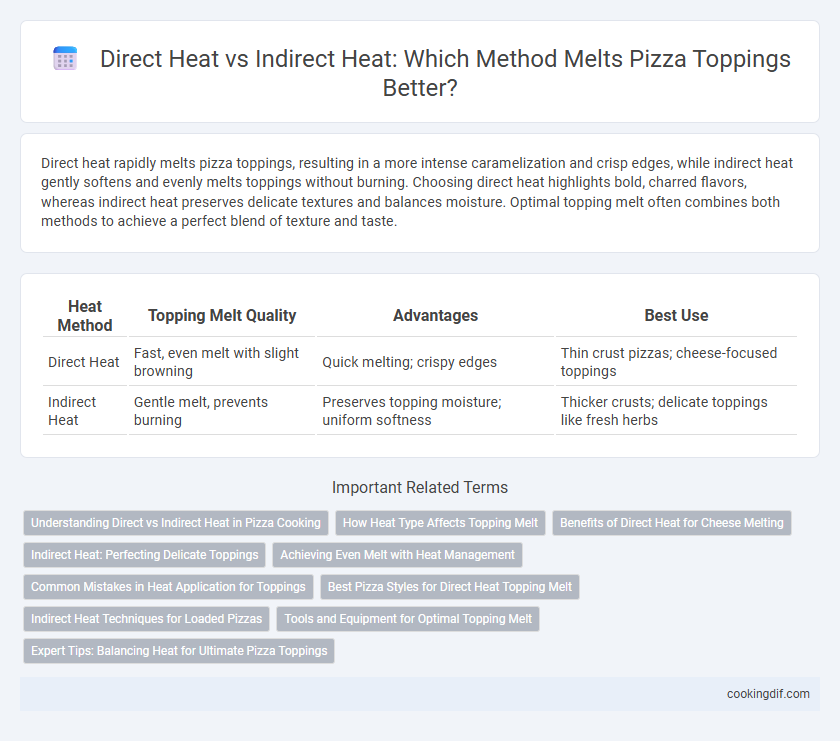Direct heat rapidly melts pizza toppings, resulting in a more intense caramelization and crisp edges, while indirect heat gently softens and evenly melts toppings without burning. Choosing direct heat highlights bold, charred flavors, whereas indirect heat preserves delicate textures and balances moisture. Optimal topping melt often combines both methods to achieve a perfect blend of texture and taste.
Table of Comparison
| Heat Method | Topping Melt Quality | Advantages | Best Use |
|---|---|---|---|
| Direct Heat | Fast, even melt with slight browning | Quick melting; crispy edges | Thin crust pizzas; cheese-focused toppings |
| Indirect Heat | Gentle melt, prevents burning | Preserves topping moisture; uniform softness | Thicker crusts; delicate toppings like fresh herbs |
Understanding Direct vs Indirect Heat in Pizza Cooking
Direct heat in pizza cooking involves placing the pizza close to the heat source, resulting in a quicker melt of toppings and a crispier crust due to intense, focused warmth. Indirect heat uses radiant heat without exposing the pizza directly to flames, allowing toppings to melt evenly while preventing burning and enabling a chewier, more uniform crust texture. Understanding the balance between direct and indirect heat optimizes topping melt and crust development for perfect pizza results.
How Heat Type Affects Topping Melt
Direct heat causes rapid melting and caramelization of pizza toppings, creating a crispy texture and intensified flavors, while indirect heat results in a more gradual melt, preserving moisture and preventing toppings from burning. High temperatures from direct heat quickly liquefy cheese and crisp ingredients like pepperoni, enhancing the overall texture. Indirect heat is ideal for delicate toppings such as fresh vegetables and herbs, ensuring even cooking without overcooking or drying out.
Benefits of Direct Heat for Cheese Melting
Direct heat enhances cheese melting by providing intense, immediate warmth that creates a perfectly bubbly, golden-brown crust. This method ensures even melting and caramelization, intensifying the flavor and texture of pizza toppings. Pizzas cooked with direct heat benefit from a crispier, more appetizing surface while maintaining a gooey, evenly melted cheese layer.
Indirect Heat: Perfecting Delicate Toppings
Indirect heat offers a gentle cooking environment that preserves the integrity of delicate pizza toppings such as fresh herbs, thinly sliced vegetables, and soft cheeses. This method ensures even melting and prevents burning or overcooking, maintaining vibrant flavors and textures. Utilizing indirect heat allows for a perfect balance between a crispy crust and tender, evenly melted toppings.
Achieving Even Melt with Heat Management
Direct heat from the oven's bottom creates a crisp crust but risks uneven topping melt, while indirect heat from the top or convection ensures consistent, thorough melting. Managing heat distribution by combining both methods promotes an optimal balance, resulting in toppings that melt evenly without burning. Using heat shields or adjusting rack placement can fine-tune this process for perfect pizza texture and flavor.
Common Mistakes in Heat Application for Toppings
Applying direct heat to pizza toppings often causes uneven melting and burning, particularly with delicate ingredients like fresh herbs and soft cheeses. Many home cooks mistakenly expose toppings to high direct heat for too long, resulting in scorched edges and undercooked centers. Using indirect heat allows toppings to melt gradually, preserving texture and flavor while avoiding common pitfalls like drying out or charring.
Best Pizza Styles for Direct Heat Topping Melt
Direct heat is ideal for pizza styles like Neapolitan and New York-style, where high temperatures quickly melt toppings and create a bubbly, slightly charred crust. The intense heat from wood-fired ovens or high-temperature grills ensures rapid cheese melting and caramelization of toppings, enhancing flavor and texture. This method suits pizzas cooked in under 90 seconds, preserving freshness while delivering a perfectly melted and slightly blistered topping.
Indirect Heat Techniques for Loaded Pizzas
Indirect heat techniques for loaded pizzas involve cooking the pizza with the heat source positioned away from direct contact, allowing toppings to melt evenly without burning. Utilizing methods like baking on a preheated pizza stone or in a convection oven ensures consistent heat distribution, preserving the texture and flavor of delicate ingredients such as fresh mozzarella, vegetables, and cured meats. This approach minimizes charring while achieving a perfectly melted topping and a crisp, well-cooked crust.
Tools and Equipment for Optimal Topping Melt
Using a pizza stone or steel on a pizza oven enhances direct heat transfer, ensuring a crisp crust and evenly melted toppings. Indirect heat methods, such as using a pizza screen or baking on a rack, allow toppings to melt gently without burning, preserving flavor and texture. Infrared thermometers and adjustable heat sources help control temperature precisely for optimal topping melt results.
Expert Tips: Balancing Heat for Ultimate Pizza Toppings
Expert tips for achieving perfectly melted pizza toppings emphasize balancing direct and indirect heat to prevent burning while ensuring thorough cooking. Utilizing a combination of high direct heat for a crispy crust and moderate indirect heat allows toppings like cheese and vegetables to melt evenly without drying out. Managing this heat balance enhances texture and flavor, creating the ultimate pizza experience.
Direct heat vs indirect heat for topping melt Infographic

 cookingdif.com
cookingdif.com